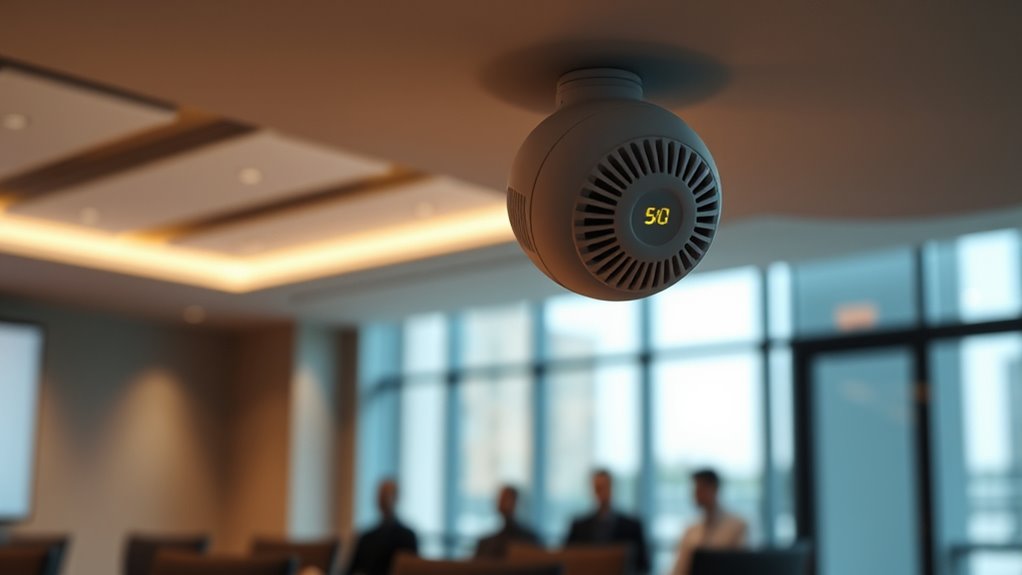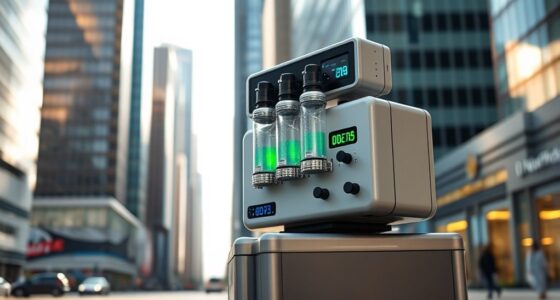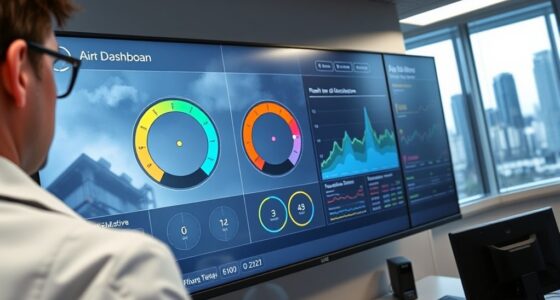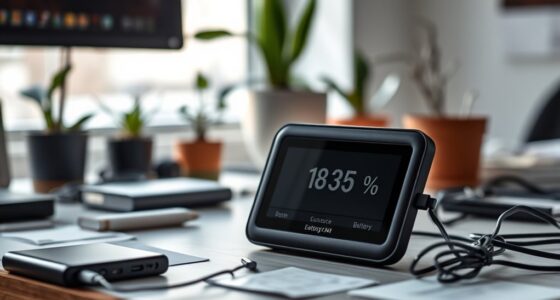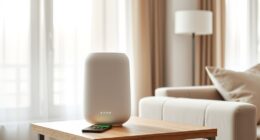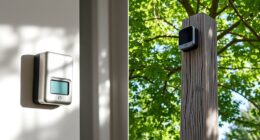CO2 sensors act as reliable proxies for occupancy levels because they measure CO2 concentrations generated by people exhaling. Higher occupancy increases the indoor CO2, while fewer occupants lead to lower levels. By monitoring these changes, you can gauge how many people are in a space indirectly. Proper calibration guarantees the sensor’s data remains accurate, which is essential for managing ventilation and air quality effectively. Keep exploring to understand how calibration impacts indoor environment management.
Key Takeaways
- CO2 sensor readings correlate with the number of occupants due to exhaled CO2 accumulation.
- Higher indoor occupancy levels lead to increased CO2 concentrations, making sensors effective proxies.
- Accurate sensor calibration ensures reliable data for estimating occupancy indirectly.
- Monitoring CO2 levels helps optimize ventilation, reflecting space utilization patterns.
- Using CO2 sensors improves indoor air quality management by estimating occupancy without direct counting.

CO2 sensors have become a valuable tool for estimating occupancy levels in indoor spaces. By measuring the concentration of carbon dioxide in the air, these sensors provide real-time insights into how many people are present in a room or building. The core idea is simple: as more individuals occupy a space, they exhale CO2, causing the levels to rise. Conversely, when the space is less crowded, CO2 concentrations tend to decrease. This relationship allows building managers and facility operators to monitor occupancy indirectly, optimizing ventilation systems and improving overall air quality. Better air quality not only enhances comfort but also reduces the risk of airborne illnesses, making CO2 sensors a crucial component of modern indoor environmental management.
However, to guarantee these sensors deliver accurate and reliable data, proper sensor calibration is essential. Calibration involves adjusting the sensor’s readings to match a known standard or reference, ensuring that the measurements reflect the true CO2 levels. Without regular calibration, sensors can drift over time due to factors like sensor aging, environmental changes, or contamination, leading to inaccurate estimates of occupancy. For example, a miscalibrated sensor might report artificially high CO2 levels, prompting unnecessary ventilation, or underestimate concentrations, which could compromise air quality. Regular calibration routines help maintain sensor accuracy, enabling you to make informed decisions based on trustworthy data. Additionally, understanding the different types of CO2 sensors can help select the most suitable device for specific applications.
In practice, calibration typically involves exposing the CO2 sensor to a controlled environment with a known CO2 concentration, often a calibration gas or a reference standard. You might need to follow manufacturer instructions for calibration frequency and procedures, which can vary depending on the sensor type and application. Some advanced sensors have automatic calibration features, but manual calibration is often recommended for critical environments or long-term deployments. Guaranteeing your sensors are correctly calibrated means you can confidently interpret changes in CO2 levels as true reflections of occupancy variations, rather than sensor errors. This precision is essential for effective ventilation control, energy efficiency, and maintaining healthy indoor air quality.
Frequently Asked Questions
How Accurate Are CO2 Sensors Compared to Other Occupancy Detection Methods?
You’ll find CO2 sensors fairly accurate for estimating occupancy, but their precision depends on proper sensor calibration and data accuracy. They excel in detecting changes in indoor air quality related to occupancy but may not match the accuracy of cameras or motion detectors in pinpointing exact numbers. Regular calibration guarantees reliable readings, helping you make better decisions based on occupancy levels and improving overall building management.
Can CO2 Sensors Differentiate Between Different Types of Occupancy?
You might think CO2 sensors can distinguish between different occupant types, but they can’t. While they detect overall occupancy levels, they don’t account for occupant behavior or differentiate between individuals like students or staff. Proper sensor calibration helps improve accuracy, but it still falls short of identifying specific occupancy patterns. So, if distinguishing occupant types matters, you’ll need additional sensors or methods beyond CO2 detection.
What Are the Limitations of Using CO2 Sensors in Large Open Spaces?
In large open spaces, CO2 sensors face limitations like uneven air circulation, which can cause inaccurate readings, and sensor calibration issues that affect reliability. You might find that CO2 levels don’t reflect actual occupancy accurately because air mixes poorly or sensors drift over time. To improve accuracy, verify proper air circulation and regularly calibrate sensors, but remember they still can’t precisely determine individual occupancy or account for ventilation variations.
How Do Environmental Factors Affect CO2 Sensor Readings?
Environmental factors like air circulation and temperature fluctuations can considerably impact your CO2 sensor readings. If airflow is strong, it disperses CO2 more quickly, causing lower readings that might underestimate occupancy. Temperature changes can also affect sensor accuracy by altering sensor response or calibration. To get reliable data, make certain of proper sensor placement, maintain consistent environmental conditions, and regularly calibrate your sensors to account for these variables.
Are There Privacy Concerns With Using CO2 Sensors for Occupancy Monitoring?
Like the spy in a classic thriller, CO2 sensors can raise privacy issues when used for occupancy monitoring. You might worry about data security and who accesses your movement info. While these sensors track air quality, it’s crucial to implement strict privacy policies and secure data storage. By doing so, you protect individual privacy, ensuring that monitoring serves safety and efficiency without invading personal space.
Conclusion
By understanding how CO2 sensors mirror occupancy levels, you can effortlessly optimize space usage and improve air quality. When the sensors detect rising CO2, it’s like the room’s telling you it’s busier, prompting you to act. This coincidence between CO2 levels and occupancy means you stay informed without constant monitoring. Embrace these sensors—they’re your silent partners, turning data into smarter decisions, and making your environment healthier and more efficient, all without lifting a finger.
